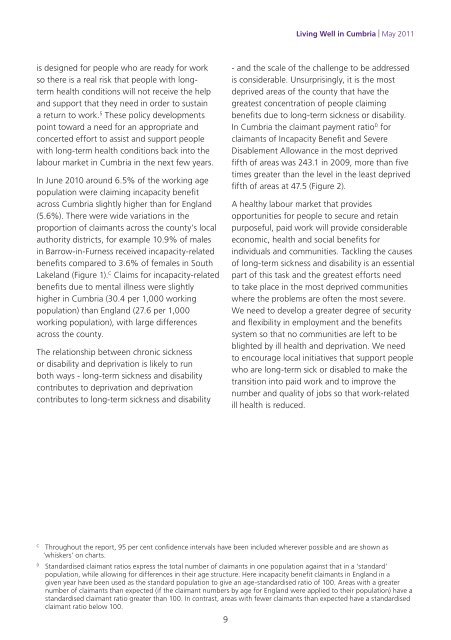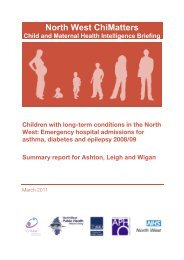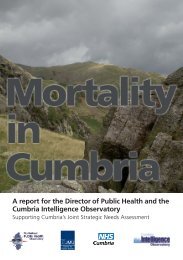Living Well in Cumbria - North West Public Health Observatory
Living Well in Cumbria - North West Public Health Observatory
Living Well in Cumbria - North West Public Health Observatory
Create successful ePaper yourself
Turn your PDF publications into a flip-book with our unique Google optimized e-Paper software.
<strong>Liv<strong>in</strong>g</strong> <strong>Well</strong> <strong>in</strong> <strong>Cumbria</strong> | May 2011<br />
is designed for people who are ready for work<br />
so there is a real risk that people with longterm<br />
health conditions will not receive the help<br />
and support that they need <strong>in</strong> order to susta<strong>in</strong><br />
a return to work. 5 These policy developments<br />
po<strong>in</strong>t toward a need for an appropriate and<br />
concerted effort to assist and support people<br />
with long-term health conditions back <strong>in</strong>to the<br />
labour market <strong>in</strong> <strong>Cumbria</strong> <strong>in</strong> the next few years.<br />
In June 2010 around 6.5% of the work<strong>in</strong>g age<br />
population were claim<strong>in</strong>g <strong>in</strong>capacity benefit<br />
across <strong>Cumbria</strong> slightly higher than for England<br />
(5.6%). There were wide variations <strong>in</strong> the<br />
proportion of claimants across the county’s local<br />
authority districts, for example 10.9% of males<br />
<strong>in</strong> Barrow-<strong>in</strong>-Furness received <strong>in</strong>capacity-related<br />
benefits compared to 3.6% of females <strong>in</strong> South<br />
Lakeland (Figure 1). C Claims for <strong>in</strong>capacity-related<br />
benefits due to mental illness were slightly<br />
higher <strong>in</strong> <strong>Cumbria</strong> (30.4 per 1,000 work<strong>in</strong>g<br />
population) than England (27.6 per 1,000<br />
work<strong>in</strong>g population), with large differences<br />
across the county.<br />
The relationship between chronic sickness<br />
or disability and deprivation is likely to run<br />
both ways - long-term sickness and disability<br />
contributes to deprivation and deprivation<br />
contributes to long-term sickness and disability<br />
- and the scale of the challenge to be addressed<br />
is considerable. Unsurpris<strong>in</strong>gly, it is the most<br />
deprived areas of the county that have the<br />
greatest concentration of people claim<strong>in</strong>g<br />
benefits due to long-term sickness or disability.<br />
In <strong>Cumbria</strong> the claimant payment ratio D for<br />
claimants of Incapacity Benefit and Severe<br />
Disablement Allowance <strong>in</strong> the most deprived<br />
fifth of areas was 243.1 <strong>in</strong> 2009, more than five<br />
times greater than the level <strong>in</strong> the least deprived<br />
fifth of areas at 47.5 (Figure 2).<br />
A healthy labour market that provides<br />
opportunities for people to secure and reta<strong>in</strong><br />
purposeful, paid work will provide considerable<br />
economic, health and social benefits for<br />
<strong>in</strong>dividuals and communities. Tackl<strong>in</strong>g the causes<br />
of long-term sickness and disability is an essential<br />
part of this task and the greatest efforts need<br />
to take place <strong>in</strong> the most deprived communities<br />
where the problems are often the most severe.<br />
We need to develop a greater degree of security<br />
and flexibility <strong>in</strong> employment and the benefits<br />
system so that no communities are left to be<br />
blighted by ill health and deprivation. We need<br />
to encourage local <strong>in</strong>itiatives that support people<br />
who are long-term sick or disabled to make the<br />
transition <strong>in</strong>to paid work and to improve the<br />
number and quality of jobs so that work-related<br />
ill health is reduced.<br />
C<br />
Throughout the report, 95 per cent confidence <strong>in</strong>tervals have been <strong>in</strong>cluded wherever possible and are shown as<br />
‘whiskers’ on charts.<br />
D<br />
Standardised claimant ratios express the total number of claimants <strong>in</strong> one population aga<strong>in</strong>st that <strong>in</strong> a ‘standard’<br />
population, while allow<strong>in</strong>g for differences <strong>in</strong> their age structure. Here <strong>in</strong>capacity benefit claimants <strong>in</strong> England <strong>in</strong> a<br />
given year have been used as the standard population to give an age-standardised ratio of 100. Areas with a greater<br />
number of claimants than expected (if the claimant numbers by age for England were applied to their population) have a<br />
standardised claimant ratio greater than 100. In contrast, areas with fewer claimants than expected have a standardised<br />
claimant ratio below 100.<br />
9











